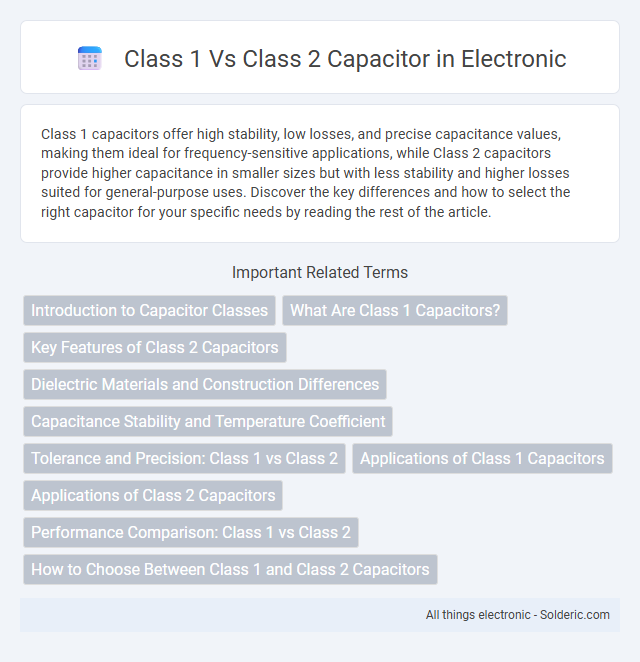Class 1 capacitors offer high stability, low losses, and precise capacitance values, making them ideal for frequency-sensitive applications, while Class 2 capacitors provide higher capacitance in smaller sizes but with less stability and higher losses suited for general-purpose uses. Discover the key differences and how to select the right capacitor for your specific needs by reading the rest of the article.
Comparison Table
| Feature | Class 1 Capacitors | Class 2 Capacitors |
|---|---|---|
| Dielectric Material | Stable materials like C0G/NP0 | High permittivity ceramics like X7R, Y5V |
| Capacitance Stability | Very high, +-30 ppm/degC | Moderate, +-15% to +-30% over temperature |
| Temperature Range | -55degC to +125degC | -55degC to +85degC or +125degC (dependent on type) |
| Dielectric Constant | Low (around 10) | High (up to 3000) |
| Applications | Timing circuits, filters, oscillators (high stability) | Decoupling, bypass, general purpose (high capacitance) |
| Capacitance Range | Low capacitance (pF to nF range) | Higher capacitance (nF to mF range) |
| Loss Tangent (Dissipation Factor) | Very low (approx. 0.001) | Higher (up to 0.05) |
| Cost | Higher cost | Lower cost |
Introduction to Capacitor Classes
Class 1 capacitors offer high stability and low losses, making them ideal for precision applications such as RF circuits and oscillators. Class 2 capacitors provide higher capacitance values with increased dielectric losses and lower stability, suitable for general-purpose filtering and energy storage. Understanding the differences between these capacitor classes helps you select the right component for your circuit's performance and reliability requirements.
What Are Class 1 Capacitors?
Class 1 capacitors are characterized by their high stability, low loss, and precise capacitance values, typically made from ceramic materials with a linear temperature coefficient such as NP0 or C0G. These capacitors are ideal for applications requiring consistent performance over a wide temperature range and frequency spectrum, including resonant circuits and precision timing devices. You can rely on Class 1 capacitors when accuracy and minimal capacitance variation are critical to your electronic design.
Key Features of Class 2 Capacitors
Class 2 capacitors are characterized by their high dielectric constant materials, such as X7R, Y5V, and Z5U, which enable higher capacitance values in smaller sizes. They exhibit moderate stability with capacitance tolerance typically ranging from +-10% to +-20%, and their dielectric properties result in greater temperature and voltage dependence compared to Class 1 capacitors. These capacitors are widely used in applications requiring compact size and high capacitance, such as decoupling and filtering in power supplies and signal processing circuits.
Dielectric Materials and Construction Differences
Class 1 capacitors use ceramic dielectric materials like titanium oxide or zirconium oxide, providing high stability and low dielectric losses, ideal for precision applications. Class 2 capacitors utilize ferroelectric materials such as barium titanate, offering higher capacitance values but with greater variability and temperature dependence. Construction differences involve Class 1 capacitors having a more rigid, less porous ceramic structure, while Class 2 capacitors feature a more flexible ceramic composition that enhances capacitance but reduces stability.
Capacitance Stability and Temperature Coefficient
Class 1 capacitors exhibit high capacitance stability with minimal variation across temperature changes, boasting low-temperature coefficients typically around +-30 ppm/degC, making them ideal for precision applications. Class 2 capacitors, in contrast, have higher capacitance values but experience significant changes with temperature variations, often with coefficients ranging from -800 ppm/degC to -3000 ppm/degC, resulting in reduced stability. This fundamental difference makes Class 1 capacitors suitable for timing circuits and oscillators, whereas Class 2 capacitors are preferred for high-capacitance, non-critical filtering tasks.
Tolerance and Precision: Class 1 vs Class 2
Class 1 capacitors offer tight tolerance and high precision, typically within +-1% to +-5%, making them ideal for applications requiring stable capacitance values over temperature and frequency variations. Class 2 capacitors provide looser tolerance ranges, often +-10% to +-20%, due to their higher dielectric constants and variability under different conditions. Your choice depends on whether precision or higher capacitance density is more critical for the circuit's performance.
Applications of Class 1 Capacitors
Class 1 capacitors, known for their stable capacitance and low dielectric loss, are widely used in precision timing circuits, RF oscillator circuits, and filters where high-frequency stability is crucial. These capacitors maintain consistent performance under varying temperature and voltage conditions, making them ideal for applications in communication equipment, medical devices, and aerospace electronics. Their reliability in maintaining capacitance ensures accurate signal processing and minimal distortion in sensitive electronic systems.
Applications of Class 2 Capacitors
Class 2 capacitors are widely utilized in electronic applications requiring high volumetric efficiency and moderate stability, such as decoupling, filtering, and timing circuits in consumer electronics, automotive systems, and telecommunications. Their ability to store a higher capacitance per unit volume compared to Class 1 capacitors makes them ideal for compact devices where space constraints are critical. Despite having higher dielectric losses and lower precision, Class 2 capacitors effectively support power supply smoothing, signal coupling, and noise suppression in various digital and analog circuits.
Performance Comparison: Class 1 vs Class 2
Class 1 capacitors offer superior stability, low loss, and high precision, making them ideal for frequency-sensitive applications like oscillators and timing circuits. In contrast, Class 2 capacitors provide higher capacitance values at smaller sizes but exhibit greater variation in capacitance with temperature, voltage, and aging, affecting performance consistency. Selecting between Class 1 and Class 2 capacitors depends on the trade-off between precision and capacitance density required for the specific electronic application.
How to Choose Between Class 1 and Class 2 Capacitors
Choosing between Class 1 and Class 2 capacitors depends on the specific application requirements such as stability, capacitance range, and cost. Class 1 capacitors offer low dielectric loss, high stability, and precise capacitance, making them ideal for high-frequency and timing circuits. Class 2 capacitors provide higher capacitance values at a lower cost but have lower stability and higher temperature coefficients, suitable for general-purpose decoupling and filtering applications.
Class 1 vs class 2 capacitor Infographic

 solderic.com
solderic.com